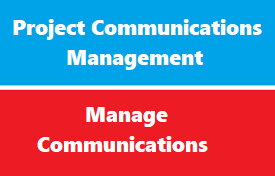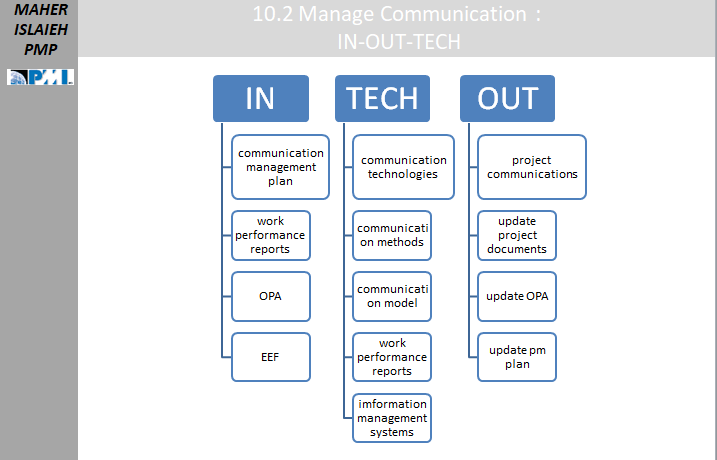introduction
Manage Communications is the process of creating, collecting, distributing, storing, retrieving, and the ultimate disposition of project information in accordance to the communications management plan.
The key benefit of this process is that it enables an efficient and effective communications flow between project stakeholders.
Communication Blockers:
Communication Blockers:
- noise surrounding
- distance between parties
- improper encoding message
- negative statements
- hostility
- deferent cultural
- unclear language
Type of Performance Reports :
Type of Performance Reports :
status report :
- describe where the project currently stand regarding performance measurement baseline
progress report :
- what has accomplished (in past)
trend repots :
- examine project result over time to see if performance improving or deteriorating
forecast report :
- predict future status and performance
variance report :
- compare actual result to baseline.
earned value report :
- please back to EVM
lesson learned documentation :
- report on performance for future project
information Management Systems
information Management Systems:
- information management systems, called also (record management system ): contain The proposal, procurement statement of work, and the contract terms and conditions are all records that need to be documented and indexed. BUT negotiation is NOT necessary to be recorded
process inputs -techniques - outputs
Inputs
- communication management plan
- work performance reports
- OPA
- EEF
Techniques
- communication technologies
- communication methods
- communication model
- work performance reports
- information management systems
Outputs
- project communications
- update project documents
- update OPA
- update pm plan
process inputs
Manage Communications Plan
Project Management Plan
the project management plan is really not a single plan, but a collection of
- plans from all of the knowledge areas
- some additional supporting plans (change management, configuration management, and requirements management)
- performance baselines for the three basic constraints of scope, schedule (time) and cost
- supporting documents (such as issue log, change log, risk register, stakeholder register)
Project Documents
- Change log– this records both the changes that were accepted and will be implemented on the project, as well as those that were rejected. Those stakeholders that are impacted by the change will be communicated to during the course of this process.
- Issue log–a risk is a potential problem or opportunity, and will be listed on the risk register, but if a negative risk becomes actualized, it becomes not a potential problem, but a real problem, and is put on the issue log. Those stakeholders that are impacted by the issue and its resolution will be communicated to during the course of this process.
- Lessons learned register–in regards to communications, any lessons learned about the management of communications during the course of this process will be recorded in the lessons learned register (the output of process Manage Project Knowledge) so that they can be applied during the remainder of the project.
- Quality report–the quality report, an output of process Manage Quality, includes the following Quality issues & Product/project improvements (from Quality Control) & Process improvements (from Quality Assurance)
- Risk report–an output of process (Identify Risks), this presents information on the following which should be communicated to risk owners and other impacted stakeholders:
- Source of overall product risk
- Summary information on identified individual project risks
- Stakeholder register–an output of process 13.1 Identify Stakeholders, this is a crucial input for this process, as it identifies the individuals and groups that will need various types of information.
Work Performance Reports.
First of all recall the information hierarchy when it comes to projects.
- Work performance data shows the actual results that were generated in the recent reporting period.
- Work performance information is the result of taking the work performance data (showing the actual results) with the project management plan to see if there is a variance in what was actually done versus what was planned to be done. Work performance information is shared with members of the project team.
- Work performance reports are the result of taking the work performance information, which indicates if there is a variance between the actual results and the planned work, and analyzing the variances found to find their source and, if possible, suggest a corrective or preventive action. Work performance reports are shared with concerned stakeholders, and that is why they are inputs to this communications process. Examples of work performance reports that may be communicated to stakeholders include the following:
Enterprise Environmental Factors
- Personnel administration policies, especially those that are based on regulations or legal requirements
- Organizational culture and governance framework
- Communication trends and/or practices
- Stakeholder risk thresholds
Organization Process Assets
- Corporate policies and procedures for social media
- Corporate policies and procedures with respect to issue, risk, change, and data management
- Organizational communication requirements
- Standardized guidelines for exchange, storage, and retrieval of information
- Historical information from previous similar projects, including the lessons learned repository.
process techniques
Manage Communications: Tools and Techniques
Communication Technology
Please consider the following
- Availability and reliability of technology–this is important when choosing any type of technology.
- Also, setting ground rules for virtual meetings is important, so that, for example mute their phones when not speaking in order to eliminate background noise for the other people on the call.
- Ease of use–if communications technology is unfamiliar to people, there should be training events planned in order to get them up to speed so that, for example, meetings are not interrupted by people not knowing how to properly use the features of the communications platform.
- Project environment–This will determine whether meetings are face-to-face or in a virtual environment.
- the cultures which the organization operates.
- Confidentiality of information–There may be some proprietary information which should not be shared with certain outside groups,
- Organizational culture–many of the ground rules for communication on the project will be ones that are set by the organization that is doing the project.
Communications Methods
There are three basic communications methods used to share information among project team members and project stakeholders. These can be broadly classified as follows:
- Interactive communication (one-on-one or many-to-many)–this is a multi-directional exchange of information.
- Push communication (one-to-many)–this is information sent to specific recipients who need to receive it.
- Pull communication (many-to-one)–requires the recipients to access content at their own discretion subject to security procedures; usually reserved for large complex information sets, or for large audiences.
Communication Skills
There are many sets of skills needed in communication. Here are some of them:
- Communication competence–this is mainly dealing with interactive (one-on-one) communication.
- Feedback–In your role as project manager, you will need to give feedback to your members to correct behavior that does not conform to the ground rules set at the beginning of the project or that addresses a conflict that has arisen between members.
- Any such “negative” feedback should be accompanied by the following to reduce the resistance on the part of the Nonverbal–when you are speaking, learn to use vocal variety
- Presentations–clear and effective presentations are important. You need to get across the four categories of preferences people have in communication.
- Prepared speeches–this is where you learn public speaking skills to make your presentations more effective
- Table topics–this is where you learn skills in answering questions (useful for interviews or Q&A at the end of your presentations)
- Evaluations–this is where you learn skills in giving feedback which is welcome and useful for the person receiving it and which effective in getting that person to improve his or her performance.
Project Management Information System (PMIS)
This is a software tool like Microsoft Project which can be use to help manage the following:
- Project management–this can help you establish a schedule, and create a dashboard to help monitor progress in maintaining that schedule
- Electronic communications–this can help you with various forms of communication with project team members and stakeholders on the project
- Social media–helps form online communities that can engage stakeholders with what’s going on in the project
Project Reporting
- This is a matter of taking work performance information (the comparison of the actual work with the work as projected in the plan) and putting it in a useful form as work performance reports that go out to the stakeholders. The most important information should be sent out to relevant stakeholders on a regular basis, although you should also be prepared to send out information as requested by key stakeholders.
Interpersonal and Team Skills
These are skills that are used in working one-on-one with project team members (interpersonal skills) and the project team as a whole in meetings (team skills).
- Active listening
- Conflict management
- different perspectives that can result in a win-sin situation.
- Cultural awareness
- Meeting management–project meetings are the bane of every project manager’s existence
- Networking–This is either personal, face-to-face networking or virtual in the form of e-mails and/or social media.
- Political awareness–this helps with influencing actions of stakeholders and increasing their support for the project.
Meetings
- meeting has been discussed many time previously .
process Outputs
Manage Communications
Project Communications
There are mainly reports to stakeholders about the status of the project, like :
- Performance reports
- Deliverable status
- Schedule progress
- Cost incurred
- Presentations (from meetings)
Project Management Plan Updates
The main update i:
- Communications Management Plan-if changes are made to the communications approach during the process Control Communications, then these get implemented into the Communications Management Plan as a result of this process, and the changes are reflected in the Communications Management Plan.
- Stakeholder Engagement Plan–if as a result of this process, any stakeholder communication requirements or agreed-upon communications strategies are changed, these need to be updated in the Stakeholder Engagement Plan.
Project Documents Updates
- Issue log–if any issues related to communications on the project are uncovered as a result of this process, these issues are added to the issue log.
- Lessons learned register–if challenges are encountered during this process related to communications, then how those challenges could have been avoided, as well as how an improved approach worked well for managing communications are recorded in the lessons learned register so that they will have an impact on communications for the rest of the project.
- Project schedule–the project schedule may needs to be updated to reflect any new communication activities taken up on the project (if additional meetings are called for, for example)
- Risk register–any risks that deal primarily with managing communications are added to the register.
- Stakeholder register–information regarding communications activities with regards to particular project stakeholders is put in this register.
Organizational Process Assets Updates
- Project records used on the project (memos, correspondence, meeting minutes)
- Project reports and presentations (those shown in meetings or prepared as a result of meetings)


